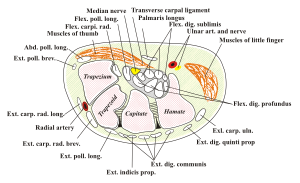Carpal tunnel syndrome
| Carpal tunnel syndrome | |
|---|---|
 |
|
| Transverse section at the wrist. The median nerve is colored yellow. The carpal tunnel consists of the bones and transverse carpal ligament. | |
| Classification and external resources | |
| Specialty | Orthopedic surgery, plastic surgery |
| ICD-10 | G56.0 |
| ICD-9-CM | 354.0 |
| OMIM | 115430 |
| DiseasesDB | 2156 |
| MedlinePlus | 000433 |
| eMedicine | orthoped/455 pmr/21 emerg/83 radio/135 |
| MeSH | D002349 |
Carpal tunnel syndrome (CTS) is a medical condition due to compression of the median nerve as it travels through the wrist at the carpal tunnel. The main symptoms are pain, numbness, and tingling, in the thumb, index finger, middle finger, and the thumb side of the ring fingers. Symptoms typically start gradually and during the night. Pain may extend up the arm. Weak grip strength may occur and after a long period of time the muscles at the base of the thumb may waste away. In more than half of cases both sides are affected.
Risk factors include obesity, repetitive wrist work, pregnancy, and rheumatoid arthritis. There is tentative evidence that hypothyroidism increases the risk. It is unclear if diabetes plays a role. The use of birth control pills does not affect the risk. Types of work that are associated include computer work, work with vibrating tools, and work that requires a strong grip. Diagnosis is suspected based on signs, symptoms, and specific physical tests and may be confirmed with electrodiagnostic tests. If muscle wasting at the base of the thumb is present, the diagnosis is likely.
Being physically active can decrease the risk of developing CTS. Symptoms can be improved by wearing a wrist splint or with corticosteroid injections. Taking NSAIDs or gabapentin does not appear to be useful. Surgery to cut the transverse carpal ligament is effective with better results at a year compared to non surgical options. Further splinting after surgery is not needed. Evidence does not support magnet therapy.
...
Wikipedia
